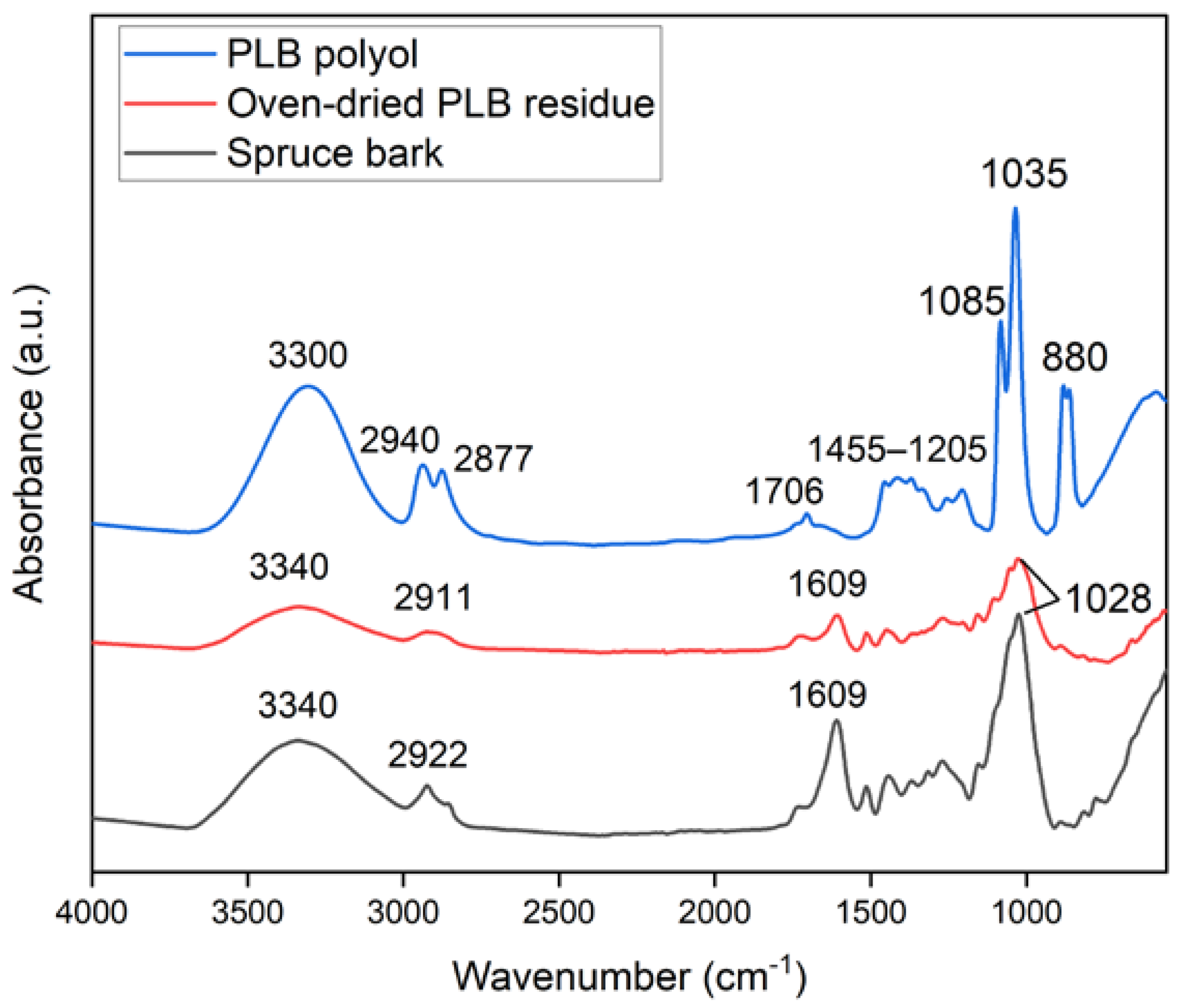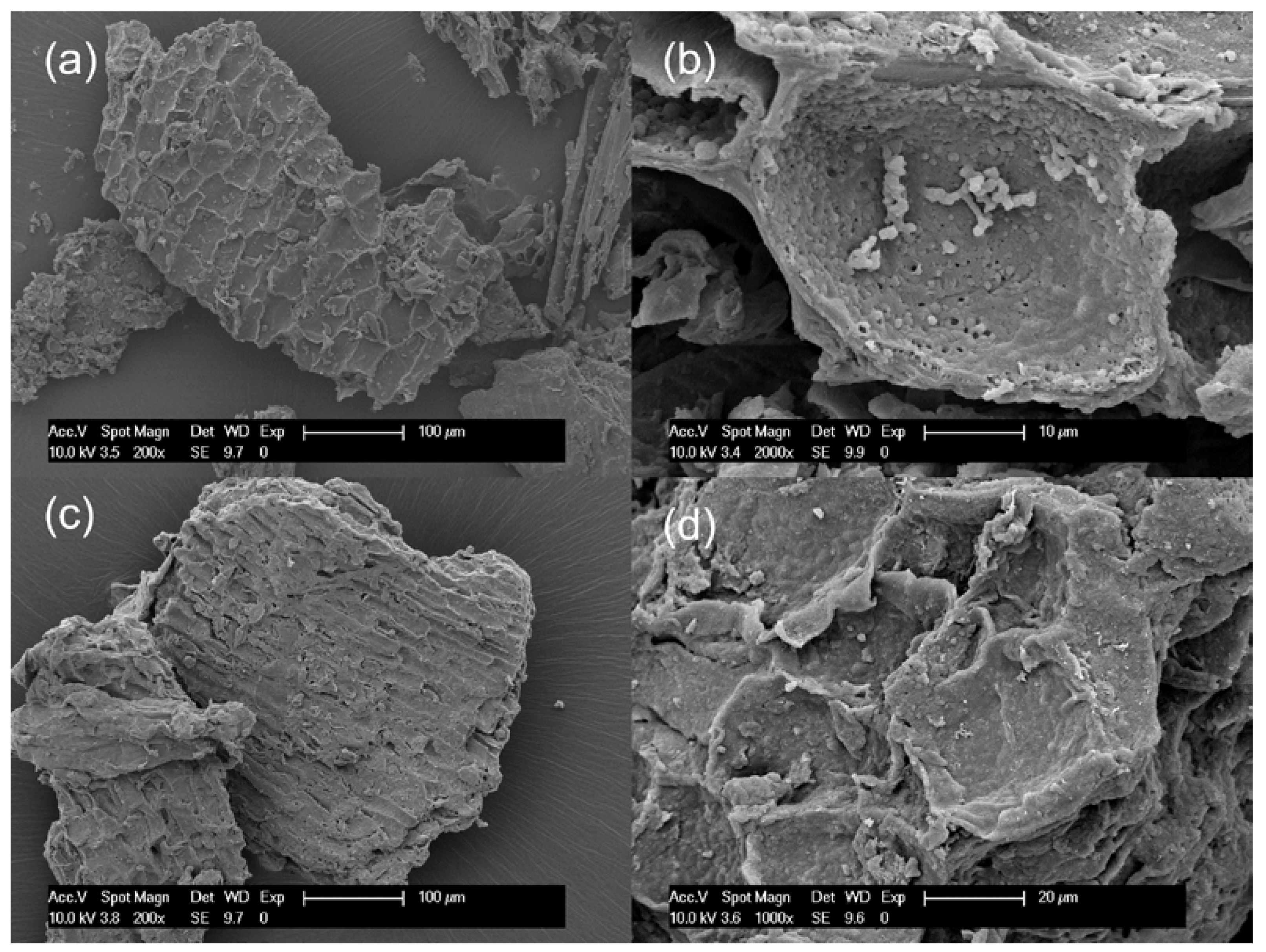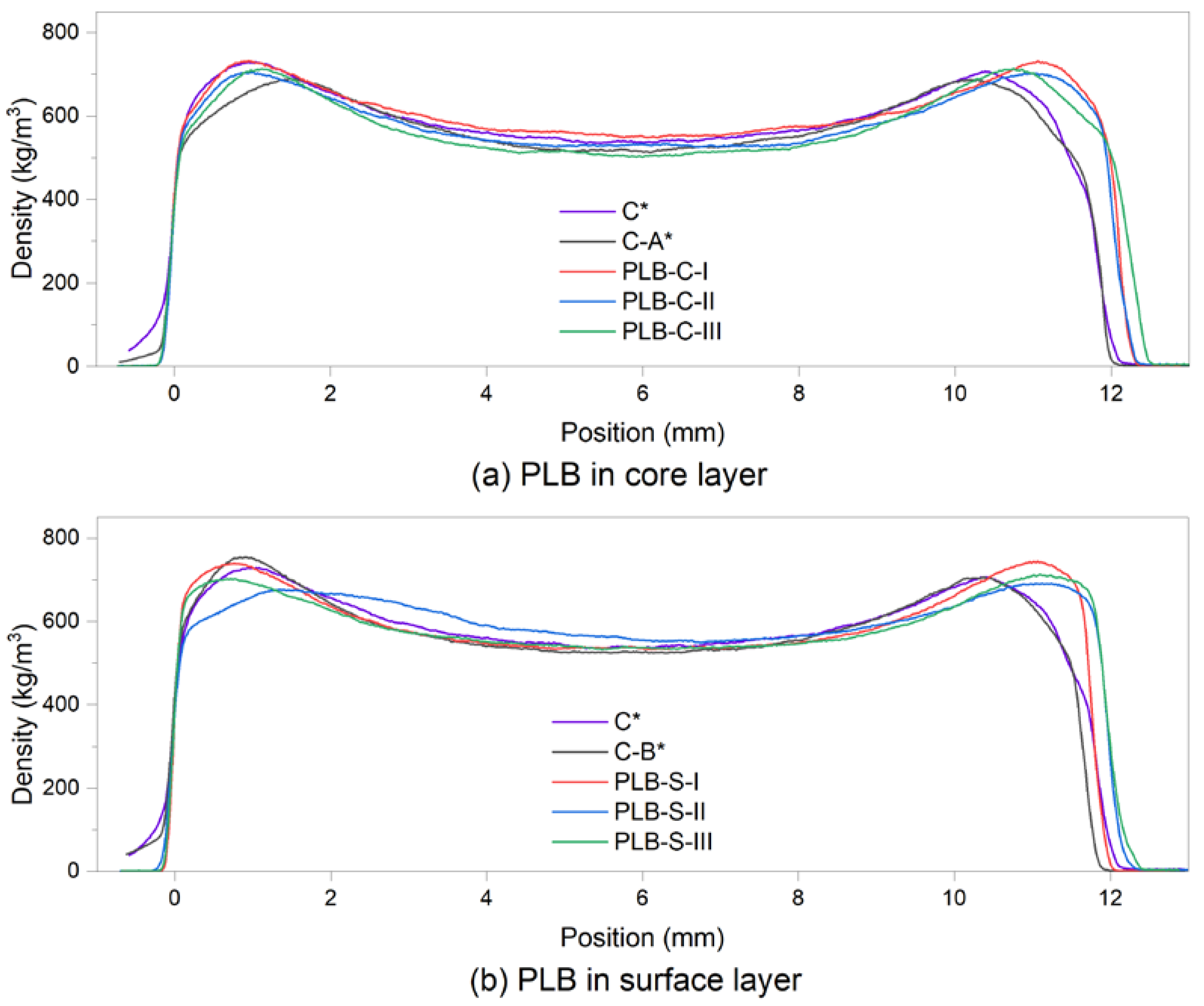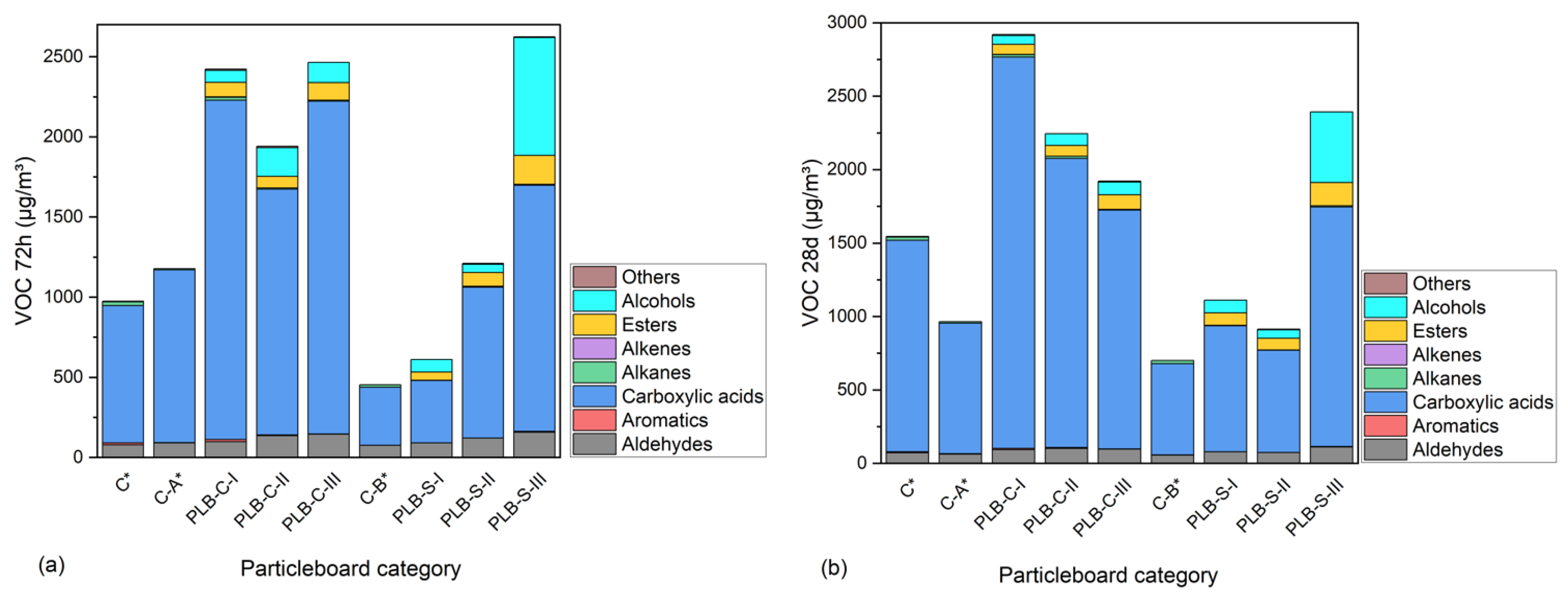Properties and Emissions of Three-Layer Particleboards Manufactured with Mixtures of Wood Chips and Partially Liquefied Bark
Abstract
1. Introduction
2. Materials and Methods
2.1. Materials
2.2. Partial Liquefaction Process
2.3. Characterization of Partially Liquefied Bark
2.4. Three-Layer Particleboard Production
2.5. Particleboard Testing
2.6. Statistical Analysis
3. Results and Discussions
3.1. Characterization of PLB Polyol and Residue
3.2. Physical Properties of Particleboards
3.3. Mechanical and Water-Related Properties of Particleboards
3.4. Formaldehyde and VOCs Emissions
4. Conclusions
Author Contributions
Funding
Institutional Review Board Statement
Informed Consent Statement
Data Availability Statement
Acknowledgments
Conflicts of Interest
Appendix A
| VOCs Detected | C* | C-A* | PLB-CO-I | PLB-CO-II | PLB-CO-III | C-B* | PLB-SUR-I | PLB-SUR-II | PLB-SUR-III |
|---|---|---|---|---|---|---|---|---|---|
| Formaldehyde | 40 | 48 | 44 | 66 | 63 | 49 | 57 | 72 | 76 |
| Acetaldehyde | 20 | 21 | 20 | 40 | 34 | 15 | 22 | 27 | 23 |
| Acetic acid | 728 | 793 | 1819 | 1082 | 1342 | 314 | 270 | 624 | 1095 |
| Propionic acid | 117 | 241 | 263 | 379 | 592 | 48 | 107 | 264 | 390 |
| Isobutyric acid | 4 | 12 | 18 | ||||||
| Tolunene | 6 | 6 | 3 | 6 | |||||
| Hexanal | 4 | 5 | 6 | 6 | 6 | 2 | 2 | 4 | 2 |
| Butyric acid | 5 | 13 | 28 | 29 | 47 | 12 | 26 | 50 | |
| Furfural | 3 | 6 | 11 | 12 | 18 | 5 | 7 | 10 | 40 |
| Styrene | 6 | 1.5 | 7 | 2 | 1.5 | ||||
| Valeric acid | 2 | 6 | 31 | 41 | |||||
| Heptanal | 1.5 | 2 | 5 | ||||||
| Diethyl phtalate | 3 | ||||||||
| Diethylenglycol monobutylether acetate | 1.5 | ||||||||
| alpha-Pinene | 1.5 | 2 | 2 | 2 | |||||
| Benzaldehyde | 5 | 6 | 12 | 11 | 18 | 3 | 3 | 7 | 15 |
| Hexanoic acid | 4 | 21 | 8 | 36 | 27 | ||||
| Hexamethylcyclotrisiloxane | 4 | 3 | |||||||
| Octamethylcyclotetrasiloxane | 6 | 4 | 7 | 2 | 4 | 11 | 2 | ||
| Octanal | 3 | 4 | 5 | 5 | 2 | ||||
| 3-Carene | 1 | 1.5 | 2 | ||||||
| Nonanal | 3 | 5 | 3 | 3 | 3 | 3 | 4 | ||
| Decamethylcyclopentasiloxane | 7 | 1.5 | 7 | 3 | 1.5 | ||||
| Decanal | 1.5 | 1.5 | 3 | ||||||
| Decamethylciclohexasiloxane | 2 | 2 | 4 | 2 | |||||
| alpha-Terpineol | 5 | 1.5 | 2 | 3 | |||||
| n-Octyl acrylate | 3 | 51 | |||||||
| Tetramethylene sulfone | 5 | 9 | 3 | ||||||
| Diethylene glycol diacetate | 5 | ||||||||
| Ethylene glycol | 70 | 26 | 46 | 47 | 50 | 590 | |||
| Triethylene glycol diacetate | 3 | ||||||||
| 1,2-Ethanediol monoacetate | 77 | 50 | 85 | 180 | |||||
| 1,2-Ethanediol acetate | 11 | 108 | |||||||
| 1,2-Ethanediol monoformate | 65 | 79 | 32 | 136 | |||||
| 1,2-Ethanediol diformate | 63 | ||||||||
| Diethylenglycole monobutylether acetate | 1.5 | ||||||||
| 3-Isopropyl-1-Pentanol | 5 | ||||||||
| 1-Pentanol | 19 | 6 | |||||||
| Dodecyl acrylate | 8 | ||||||||
| TVOC (Total Volatile Organic Compound) | 976 | 1183 | 2424 | 1944 | 2468 | 453 | 611 | 1211 | 2625 |
| VOCs Detected | C* | C-A* | PLB-CO-I | PLB-CO-II | PLB-CO-III | C-B* | PLB-SUR-I | PLB-SUR-II | PLB-SUR-III |
|---|---|---|---|---|---|---|---|---|---|
| Formaldehyde | 47 | 47 | 50 | 69 | 69 | 47 | 64 | 69 | 73 |
| Acetaldehyde | 10 | 5 | 10 | 14 | 8 | 2 | 6 | 2 | 14 |
| Acetic acid | 1029 | 473 | 2112 | 1357 | 937 | 482 | 654 | 370 | 1065 |
| Propionic acid | 378 | 364 | 494 | 488 | 553 | 139 | 182 | 296 | 505 |
| Isobutyric acid | 3 | 17 | 14 | ||||||
| Tolunene | 5 | 6 | 4 | 2 | 3 | ||||
| Hexanal | 3 | 2 | 4 | 3 | 2 | 2 | 2 | 2 | 3 |
| Butyric acid | 21 | 17 | 40 | 55 | 52 | 23 | 31 | 61 | |
| Furfural | 9 | 6 | 14 | 13 | 12 | 10 | 12 | 9 | 36 |
| Styrene | 2 | 2 | 2 | 2 | 2 | ||||
| Valeric acid | 5 | 9 | 52 | 22 | |||||
| Heptanal | 2 | 2 | |||||||
| Diethyl Phtalate | 3 | ||||||||
| Diethylenglycol monobutylether acetate | 2 | ||||||||
| alpha-Pinene | 2 | 2 | 2 | ||||||
| Benzaldehyde | 7 | 5 | 16 | 11 | 14 | 3 | 6 | 17 | |
| Hexanoic Acid | 7 | 24 | 19 | 47 | |||||
| Hexamethylcyclotrisiloxane | 2 | 5 | |||||||
| Octamethylcyclotetrasiloxane | 6 | 5 | 7 | 4 | 2 | 15 | 3 | ||
| Octanal | 3 | 2 | 6 | 2 | 2 | ||||
| 3-Carene | 1 | 2 | |||||||
| Nonanal | 2 | 2 | 8 | 5 | 2 | 4 | |||
| Decamethylcyclopentasiloxane | 7 | 2 | 3 | 5 | 2 | 2 | |||
| Decanal | 2 | 3 | 5 | ||||||
| Decamethylciclohexasiloxane | 2 | 6 | |||||||
| alpha-Terpineol | 3 | 2 | 2 | ||||||
| n-Octyl acrylate | 3 | 2 | |||||||
| Tetramethylene Sulfone | 2 | 6 | 2 | ||||||
| Dodecamethylciclohexasiloxane | 2 | ||||||||
| Diethylene glycol diacetate | 2 | ||||||||
| Ethylene Glycol | 6 | 8 | 18 | 51 | 58 | 398 | |||
| Triethylene glycol diacetate | 3 | ||||||||
| 1,2-Ethanediol monoacetate | 58 | 85 | 79 | 158 | |||||
| 1,2-Ethanediol acetate | 71 | 93 | |||||||
| 1,2-Ethanediol monoformate | 71 | 66 | 36 | 82 | |||||
| 1,2-Ethanediol diformate | 2 | ||||||||
| Diethylenglycole monobutylether acetate | 2 | ||||||||
| 3-Isopropyl-1-Pentanol | 2 | ||||||||
| 1-Pentanol | 16 | 6 | |||||||
| Dodecyl acrylate | 2 | ||||||||
| TVOC (Total Volatile Organic Compound) | 1552 | 970 | 2879 | 2276 | 1993 | 710 | 1123 | 920 | 2435 |
References
- Owodunni, A.A.; Lamaming, J.; Hashim, R.; Taiwo, O.F.A.; Hussin, M.H.; Mohamad Kassim, M.H.; Bustami, Y.; Sulaiman, O.; Amini, M.H.M.; Hiziroglu, S. Adhesive application on particleboard from natural fibers: A review. Polym. Compos. 2020, 41, 4448–4460. [Google Scholar] [CrossRef]
- Stark, N.; Cai, Z. Wood-based composite materials: Panel products, glued laminated timber, structural composite lumber, and wood–nonwood composites. In Wood Handbook: Wood as an Engineering Material: Chapter 11; U.S. Department of Agriculture, Forest Service, Forest Products Laboratory: Madison, WI, USA, 2021; pp. 11.1–11.28. [Google Scholar]
- Borysiuk, P.; Jenczyk-Tolloczko, I.; Auriga, R.; Kordzikowski, M. Sugar beet pulp as raw material for particleboard production. Ind. Crops Prod. 2019, 141, 111829. [Google Scholar] [CrossRef]
- FAO. FAOSTAT: Forestry Production and Trade; FAO: Rome, Italy, 2021. [Google Scholar]
- Mohanty, A.K.; Misra, M.; Drzal, L.T. Sustainable Bio-Composites from Renewable Resources: Opportunities and Challenges in the Green Materials World. J. Polym. Environ. 2002, 10, 19–26. [Google Scholar] [CrossRef]
- Neitzel, N.; Hosseinpourpia, R.; Walther, T.; Adamopoulos, S. Alternative Materials from Agro-Industry for Wood Panel Manufacturing—A Review. Materials 2022, 15, 4542. [Google Scholar] [CrossRef]
- Wronka, A.; Kowaluk, G. The Influence of Multiple Mechanical Recycling of Particleboards on Their Selected Mechanical and Physical Properties. Materials 2022, 15, 8487. [Google Scholar] [CrossRef]
- Hashim, R.; Nadhari, W.N.A.W.; Sulaiman, O.; Kawamura, F.; Hiziroglu, S.; Sato, M.; Sugimoto, T.; Seng, T.G.; Tanaka, R. Characterization of raw materials and manufactured binderless particleboard from oil palm biomass. Mater. Des. 2011, 32, 246–254. [Google Scholar] [CrossRef]
- Filgueira, D.; Moldes, D.; Fuentealba, C.; García, D.E. Condensed tannins from pine bark: A novel wood surface modifier assisted by laccase. Ind. Crops Prod. 2017, 103, 185–194. [Google Scholar] [CrossRef]
- da Silva Araujo, E.; Lorenço, M.S.; Zidanes, U.L.; Sousa, T.B.; da Silva Mota, G.; de Nazaré de Oliveira Reis, V.; Gomes da Silva, M.; Mori, F.A. Quantification of the bark Myrcia eximia DC tannins from the Amazon rainforest and its application in the formulation of natural adhesives for wood. J. Clean. Prod. 2021, 280, 124324. [Google Scholar] [CrossRef]
- Jiang, W.; Kumar, A.; Adamopoulos, S. Liquefaction of lignocellulosic materials and its applications in wood adhesives—A review. Ind. Crops Prod. 2018, 124, 325–342. [Google Scholar] [CrossRef]
- Jiang, W.; Hosseinpourpia, R.; Biziks, V.; Ahmed, S.A.; Militz, H.; Adamopoulos, S. Preparation of Polyurethane Adhesives from Crude and Purified Liquefied Wood Sawdust. Polymers 2021, 13, 3267. [Google Scholar] [CrossRef] [PubMed]
- Hu, S.; Luo, X.; Li, Y. Polyols and Polyurethanes from the Liquefaction of Lignocellulosic Biomass. ChemSusChem 2014, 7, 66–72. [Google Scholar] [CrossRef] [PubMed]
- Niu, M.; Zhao, G.-j.; Alma, M.H. Polycondensation reaction and its mechanism during lignocellulosic liquefaction by an acid catalyst: A review. For. Stud. China 2011, 13, 71–79. [Google Scholar] [CrossRef]
- Hassan, E.B.; Kim, M.; Wan, H. Phenol–formaldehyde-type resins made from phenol-liquefied wood for the bonding of particleboard. J. Appl. Polym. Sci. 2009, 112, 1436–1443. [Google Scholar] [CrossRef]
- Antonović, A.; Jambreković, V.; Kljak, J.; Španić, N.; Medved, S. Influence of Urea-Formaldehyde Resin Modification with Liquefied Wood on Particleboard Properties. Wood Ind./Drv. Ind. 2010, 61, 5–14. Available online: https://hrcak.srce.hr/49202 (accessed on 20 January 2023).
- Kunaver, M.; Medved, S.; Čuk, N.; Jasiukaitytė, E.; Poljanšek, I.; Strnad, T. Application of liquefied wood as a new particle board adhesive system. Bioresour. Technol. 2010, 101, 1361–1368. [Google Scholar] [CrossRef]
- Janiszewska, D. Bark liquefaction for use in three-layer particleboard bonding. Drew. Pr. Nauk. Doniesienia Komun. 2018, 61, 119–127. [Google Scholar] [CrossRef]
- Zhang, B.; Zhang, F.; Wu, L.; Gao, Z.; Zhang, L. Assessment of soybean protein-based adhesive formulations, prepared by different liquefaction technologies for particleboard applications. Wood Sci. Technol. 2021, 55, 33–48. [Google Scholar] [CrossRef]
- Jiang, W.; Adamopoulos, S.; Hosseinpourpia, R.; Žigon, J.; Petrič, M.; Šernek, M.; Medved, S. Utilization of Partially Liquefied Bark for Production of Particleboards. Appl. Sci. 2020, 10, 5253. [Google Scholar] [CrossRef]
- Jiang, W.; Adamopoulos, S.; Petric, M.; Sernek, M.; Medved, S. Particleboards with partially liquefied bark of different particle sizes. Drew. Pr. Nauk. Doniesienia Komun. 2021, 64, 43–57. [Google Scholar] [CrossRef]
- Choowang, R.; Luengchavanon, M. Oil palm trunk powder blended with citric acid directly used as wood adhesive by one step liquefaction reaction. Ind. Crops Prod. 2021, 170, 113809. [Google Scholar] [CrossRef]
- Nitu, I.P.; Rahman, S.; Islam, M.N.; Ashaduzzaman, M.; Shams, M.I. Preparation and properties of jute stick particleboard using citric acid–glycerol mixture as a natural binder. J. Wood Sci. 2022, 68, 30. [Google Scholar] [CrossRef]
- BS EN 310: 1993; Wood-Based Panels-Determination of Modulus of Elasticity in Bending and of Bending Strength. British Standard Institution: London, UK, 1993.
- BS EN 319: 1993; Particleboards and Fiberboards-Determination of Tensile Strength Perpendicular to the Plane of the Board. British Standards Institution: London, UK, 1993.
- EN 324-1: 1993; Wood-Based Panels-Determination of Dimensions of Boards Part 1: Determination of Thickness, Width and Length. European Standard: Brussels, Belgium, 1993.
- BS EN 323: 1993; Wood-Based Panels-Determination of Density in Fiberboard. British Standards Institution: London, UK, 1993.
- BS EN 317: 1993; Particleboards and Fibreboards: Determination of Swelling in Thickness after Immersion in Water. British Standards Institution: London, UK, 1993.
- BS EN 717-2: 1994; Wood-Based Panels-Determination of Formaldehyde Release—Part 2: Formaldehyde Release by the Gas Analysis Method. British Standard Instition: London, UK, 1994.
- BS EN ISO 16000-9:2006; Indoor Air-Part 9: Determintation of the Emission of Volatile Organic Compounds from Building Products and Furnishing—Emission Test Chamber Method. British Standard Institution: London, UK, 2006.
- ISO 16000-6:2011; Indoor air—Part 6: Determination of Volatile Organic Compounds in Indoor and Test Chamber Air by Active Sampling on Tenax TA Sorbent, Thermal Desorption and Gas Chromatography Using MS or MS-FID. ISO: Geneva, Switzerland, 2011.
- Janiszewska, D.; Olchowski, R.; Nowicka, A.; Zborowska, M.; Marszałkiewicz, K.; Shams, M.; Giannakoudakis, D.A.; Anastopoulos, I.; Barczak, M. Activated biochars derived from wood biomass liquefaction residues for effective removal of hazardous hexavalent chromium from aquatic environments. GCB Bioenergy 2021, 13, 1247–1259. [Google Scholar] [CrossRef]
- Huang, X.-Y.; Qi, J.-Q.; De Hoop, C.F.; Xie, J.-L.; Chen, Y.-Z. Biobased Polyurethane Foam Insulation from Microwave Liquefaction of Woody Underbrush. Bioresources 2017, 12, 8160–8179. [Google Scholar]
- Chirea, M.; Freitas, A.; Vasile, B.S.; Ghitulica, C.; Pereira, C.M.; Silva, F. Gold Nanowire Networks: Synthesis, Characterization, and Catalytic Activity. Langmuir 2011, 27, 3906–3913. [Google Scholar] [CrossRef]
- Çabuk, H.; Yılmaz, Y.; Yıldız, E. A vortex-assisted deep eutectic solvent-based liquid-liquid microextraction for the analysis of alkyl ggallates in vegetable oils. Acta Chim. Slov. 2019, 66, 385–394. [Google Scholar] [CrossRef] [PubMed]
- Geimer, R.L.; Heebink, B.G.; Hefty, F. Weathering Characteristics of Particleboard; US Department of Agriculture, Forest Service, Forest Products Laboratory: Madison, WI, USA, 1973; Volume 212.
- Korai, H. Difficulty of internal bond prediction of particleboard using the density profile. J. Wood Sci. 2021, 67, 64. [Google Scholar] [CrossRef]
- Wong, E.D.; Yang, P.; Zhang, M.; Wang, Q.; Nakao, T.; Li, K.F.; Kawai, S. Analysis of the effects of density profile on the bending properties of particleboard using finite element method (FEM). Eur. J. Wood Wood Prod. 2003, 61, 66–72. [Google Scholar] [CrossRef]
- Wong, E.D.; Zhang, M.; Wang, Q.; Kawai, S. Formation of the density profile and its effects on the properties of particleboard. Wood Sci. Technol. 1999, 33, 327–340. [Google Scholar] [CrossRef]
- Boruszewski, P.; Borysiuk, P.; Jankowska, A.; Pazik, J. Low-Density Particleboards Modified with Blowing Agents—Characteristic and Properties. Materials 2022, 15, 4528. [Google Scholar] [CrossRef]
- Johnson, S.E.; Kamke, F.A. Characteristics of phenol-formaldehyde adhesive bonds in steam injection pressed flakeboard. Wood Fiber Sci. 1994, 26, 259–269. [Google Scholar]
- Salem, M.Z.M.; Böhm, M. Understanding of Formaldehyde Emissions from Solid Wood: An Overview. BioResources 2013, 8, 4775–4790. [Google Scholar] [CrossRef]
- Dussan, K.; Girisuta, B.; Lopes, M.; Leahy, J.J.; Hayes, M.H.B. Conversion of Hemicellulose Sugars Catalyzed by Formic Acid: Kinetics of the Dehydration of D-Xylose, L-Arabinose, and D-Glucose. ChemSusChem 2015, 8, 1411–1428. [Google Scholar] [CrossRef] [PubMed]
- Schäfer, M.; Roffael, E. On the formaldehyde release of wood. Eur. J. Wood Wood Prod. 2000, 58, 259–264. [Google Scholar] [CrossRef]
- EN 13986:2004; Wood-Based Panels for Use in Construction—Characteristics, Evaluation of Conformity and Marking. European Standard: Brussels, Belgium, 2004.
- Akkuş, M.; Akbulut, T.; Candan, Z. Formaldehyde emission, combustion behavior, and artificial weathering characteristics of electrostatic powder coated wood composite panels. Wood Mater. Sci. Eng. 2021, 17, 540–550. [Google Scholar] [CrossRef]
- Salem, M.Z.M.; Böhm, M.; Beránková, J.; Srba, J. Effect of some manufacturing variables on formaldehyde release from particleboard: Relationship between different test methods. Build. Environ. 2011, 46, 1946–1953. [Google Scholar] [CrossRef]
- Baumann, M.G.; Lorenz, L.F.; Batterman, S.A.; Zhang, G.-Z. Aldehyde emissions from particleboard and medium density fiberboard products. For. Prod. J. 2000, 50, 75–82. [Google Scholar]
- Khazraie Shoulaifar, T.; DeMartini, N.; Ivaska, A.; Fardim, P.; Hupa, M. Measuring the concentration of carboxylic acid groups in torrefied spruce wood. Bioresour. Technol. 2012, 123, 338–343. [Google Scholar] [CrossRef]
- Kariuki, S.W.; Wachira, J.; Kawira, M.; Murithi, G. Formaldehyde Use and Alternative Biobased Binders for Particleboard Formulation: A Review. J. Chem. 2019, 2019, 5256897. [Google Scholar] [CrossRef]
- Al-Lahham, S.A.H.; Peppelenbosch, M.P.; Roelofsen, H.; Vonk, R.J.; Venema, K. Biological effects of propionic acid in humans; metabolism, potential applications and underlying mechanisms. Biochim. Biophys. Acta Mol. Cell Biol. Lipids 2010, 1801, 1175–1183. [Google Scholar] [CrossRef]
- Ernstgård, L.; Iregren, A.; Sjögren, B.; Johanson, G. Acute effects of exposure to vapours of acetic acid in humans. Toxicol. Lett. 2006, 165, 22–30. [Google Scholar] [CrossRef]
- Ulker, O.C.; Ulker, O.; Hiziroglu, S. Volatile Organic Compounds (VOCs) Emitted from Coated Furniture Units. Coatings 2021, 11, 806. [Google Scholar] [CrossRef]





| Parameter | Control | Group A | Group B | ||||||
|---|---|---|---|---|---|---|---|---|---|
| Particleboard Type | C* | C-A* | PLB-C-I | PLB-C-II | PLB-C-III | C-B* | PLB-S-I | PLB-S-II | PLB-S-III |
| Surface layer (SL)-to-core layer (CL) ratio | 0.4:0.6 | ||||||||
| SL content | 100% wood | 100% wood | 95% wood | 90.1% wood + 9.1% PLB | |||||
| CL content | 100% wood | 95% wood | 90.1% wood + 9.1% PLB | 100% wood | |||||
| MUF content in SL (%) | 12 | 12 | 12 | 12 | 10 | 8 | |||
| MUF content in CL (%) | 12 | 12 | 12 | 10 | 8 | 12 | |||
| Hardener content in SL (%) | 3 | 3 | 3 | ||||||
| Hardener content in CL (%) | 3 | 3 | 3 | ||||||
| Press temperature (°C) | 210 | ||||||||
| Pressing time (min) | 3 | ||||||||
| Dimensions (mm × mm × mm) | 450 × 450 × 12 | ||||||||
| Group | A | B | |||||||||||
|---|---|---|---|---|---|---|---|---|---|---|---|---|---|
| Board Type | C* | C-A* | PLB-C-I | PLB-C-II | PLB-C-III | p | C* | C-B* | PLB-S-I | PLB-S-II | PLB-S-III | p | |
| Thickness (mm) | Mean (SD) | 12.11 (0.08) a,b | 11.98 (0.12) a | 12.29 (0.08) c | 12.20 (0.07) b,c | 12.30 (0.16) c | < 0.001 | 12.11 (0.08) a | 11.83 (0.10) b | 11.88 (0.04) b | 12.17 (0.12) a | 12.14 (0.13) a | < 0.001 |
| Density (kg/m3) | Mean (SD) | 612.1 (32.3) a | 599.3 (33.4) a | 623.9 (31.9) a | 609.1 (43.3) a | 566.2 (58.4) a | 0.082 | 612.1 (32.3) a | 613.7 (38.0) a | 645.2 (17.3) a | 641.6 (46.3) a | 624.6 (34.3) a | 0.208 |
| Group | A | B | |||||||
|---|---|---|---|---|---|---|---|---|---|
| Board Type | C* | C-A* | PLB-C-I | PLB-C-II | PLB-C-III | C-B* | PLB-S-I | PLB-S-II | PLB-S-III |
| Max. density left (kg/m3) | 729 | 689 | 732 | 705 | 713 | 755 | 740 | 676 | 703 |
| Max. density right (kg/m3) | 707 | 688 | 731 | 702 | 713 | 706 | 745 | 691 | 713 |
| Min. density(kg/m3) | 535 | 513 | 548 | 526 | 502 | 524 | 533 | 549 | 533 |
| Medium density(kg/m3) | 604 | 587 | 615 | 592 | 581 | 596 | 605 | 609 | 597 |
| Group | Variant | TS 2 h (%) | TS 24 h (%) | WA 2 h (%) | WA 24 h (%) | ||||
|---|---|---|---|---|---|---|---|---|---|
| Avg. | St. Dev. | Avg. | St. Dev. | Avg. | St. Dev. | Avg. | St. Dev. | ||
| A | C* | 19.59 a | 2.05 | 23.78 a | 3.06 | 87.49 a | 11.87 | 98.72 a | 13.19 |
| C-A* | 20.99 a | 2.59 | 25.02 a | 2.68 | 97.70 a | 5.88 | 107.69 a,b | 4.30 | |
| PLB-C-I | 19.35 a | 2.52 | 23.11 a | 3.58 | 89.07 a | 8.92 | 97.82 a | 7.99 | |
| PLB-C-II | 19.95 a | 2.18 | 24.15 a | 2.52 | 95.77 a | 3.63 | 105.42 a | 4.06 | |
| PLB-C-III | 21.82 a | 2.54 | 25.50 a | 2.58 | 110.18 b | 9.79 | 120.76 b | 12.07 | |
| p | 0.219 | 0.494 | <0.001 | <0.001 | |||||
| B | C* | 19.59 a,b | 2.05 | 23.78 a,b | 3.06 | 87.49 a | 11.87 | 98.72 a | 13.19 |
| C-B* | 16.49 a | 0.93 | 19.69 a | 1.51 | 80.77 a | 11.24 | 94.30 a | 11.35 | |
| PLB-S-I | 17.62 a,b | 1.53 | 20.57 a,b | 2.19 | 77.28 a | 2.13 | 86.90 a | 1.77 | |
| PLB-S-II | 23.92 c | 3.61 | 28.34 c | 4.67 | 85.73 a | 7.39 | 97.33 a | 13.53 | |
| PLB-S-III | 21.12 b,c | 3.09 | 24.62 b,c | 3.43 | 88.02 a | 5.69 | 96.68 a | 6.12 | |
| p | <0.001 | <0.001 | 0.067 | 0.179 | |||||
| Particleboard Type | C* | C-A* | PLB-C-I | PLB-C-II | PLB-C-III | C-B* | PLB-S-I | PLB-S-II | PLB-S-III | E1 Limit |
|---|---|---|---|---|---|---|---|---|---|---|
| Formaldehyde emission (mg/m2·h) | 0.361 | 0.293 | 0.382 | 0.296 | 0.323 | 0.346 | 0.298 | 0.365 | 0.284 | 3.5 |
Disclaimer/Publisher’s Note: The statements, opinions and data contained in all publications are solely those of the individual author(s) and contributor(s) and not of MDPI and/or the editor(s). MDPI and/or the editor(s) disclaim responsibility for any injury to people or property resulting from any ideas, methods, instructions or products referred to in the content. |
© 2023 by the authors. Licensee MDPI, Basel, Switzerland. This article is an open access article distributed under the terms and conditions of the Creative Commons Attribution (CC BY) license (https://creativecommons.org/licenses/by/4.0/).
Share and Cite
Jiang, W.; Adamopoulos, S.; Hosseinpourpia, R.; Walther, T.; Medved, S. Properties and Emissions of Three-Layer Particleboards Manufactured with Mixtures of Wood Chips and Partially Liquefied Bark. Materials 2023, 16, 1855. https://doi.org/10.3390/ma16051855
Jiang W, Adamopoulos S, Hosseinpourpia R, Walther T, Medved S. Properties and Emissions of Three-Layer Particleboards Manufactured with Mixtures of Wood Chips and Partially Liquefied Bark. Materials. 2023; 16(5):1855. https://doi.org/10.3390/ma16051855
Chicago/Turabian StyleJiang, Wen, Stergios Adamopoulos, Reza Hosseinpourpia, Thomas Walther, and Sergej Medved. 2023. "Properties and Emissions of Three-Layer Particleboards Manufactured with Mixtures of Wood Chips and Partially Liquefied Bark" Materials 16, no. 5: 1855. https://doi.org/10.3390/ma16051855
APA StyleJiang, W., Adamopoulos, S., Hosseinpourpia, R., Walther, T., & Medved, S. (2023). Properties and Emissions of Three-Layer Particleboards Manufactured with Mixtures of Wood Chips and Partially Liquefied Bark. Materials, 16(5), 1855. https://doi.org/10.3390/ma16051855







